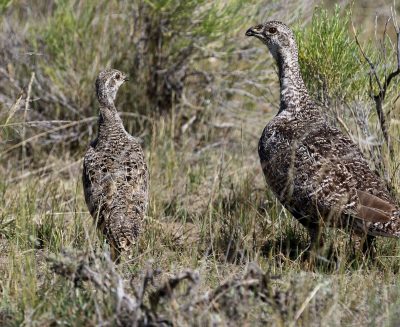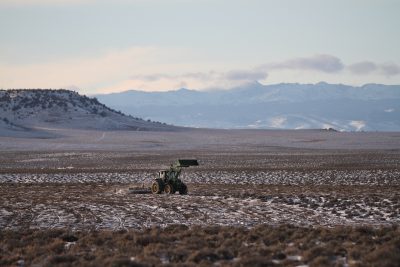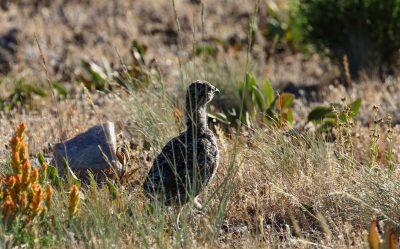Efforts to improve sage-grouse habitat through conventional management practices may be ineffective—and even counterproductive—according to research by Wyoming scientists.
Sagebrush reduction strategies, including mowing and herbicide application, are often employed to enhance habitat for the greater sage-grouse (Centrocercus urophasianus) and other sagebrush-dependent species.

The theory is that clearing large sagebrush shrubs improves food sources in sage-grouse nesting and brood-rearing habitats by allowing other, more nutritious vegetation to grow with less competition. This, in turn, should increase invertebrate populations, another food source for sage-grouse.
But a new paper published in the journal Wildlife Monographs suggests these methods may be misguided.
In a nine-year experimental study, researchers examined how greater sage-grouse populations in central Wyoming responded to mowing and applying the herbicide tebuthiuron to Wyoming big sagebrush (Artemisia tridentata wyomingensis). According to their data, these treatments did not benefit the birds.
“Some managers think, ‘Treating sagebrush for wildlife is how it’s supposed to work, and we’ll keep doing it,’” says Jeff Beck, UW professor of ecosystem science and management and principal investigator for the study. “Hopefully this will get people to start thinking, ‘If we’re going to spend money to improve habitat, we’ve got to find some other ideas.’”
Beck’s co-authors include Kurt Smith, a former UW Ph.D. student who is now an ecologist with Western EcoSystems Technology; Jason LeVan, a former UW M.S. student who is now a range and wildlife conservationist for Pheasants Forever; Anna Chalfoun, UW associate professor and assistant unit leader of the U.S. Geological Survey Wyoming Cooperative Fish and Wildlife Research Unit; Stanley Harter, a wildlife biologist with the Wyoming Game and Fish Department; Thomas Christiansen, a retired Wyoming Game and Fish Department sage-grouse program coordinator; and Sue Oberlie, a retired Bureau of Land Management wildlife biologist.
The researchers tracked behaviors and survival rates of more than 600 female greater sage-grouse in response to mowing and tebuthiuron application. They also monitored effects on invertebrate populations, sagebrush, and herbaceous vegetation. Throughout the study, responses were compared to untreated plots near the treated areas as well as off-site control plots.
Pre-treatment data were collected 2011 through 2013; mowing and tebuthiuron applications were implemented in winter and spring 2014.

After six years (2014-2019) of post-treatment monitoring, Beck and his colleagues determined that sage-grouse responses to treatment were neutral at best. “Neither mowing nor tebuthiuron treatments influenced nest success, brood success, or female survival,” they reported.
Furthermore, treatments used to reduce Wyoming big sagebrush coverage resulted in slight avoidance by sage-grouse.
Invertebrates and herbaceous vegetation also did not respond positively to reduction of Wyoming big sagebrush, indicating treatments did not improve the quantity and quality of sage-grouse food sources.
Instead, reduction of Wyoming big sagebrush cover may negatively impact sage-grouse and other species that use sagebrush shrubs to nest and seek refuge from predators, the researchers suggest.
They predict that expanding experimental treatments to larger areas may reveal greater negative effects of Wyoming big sagebrush reduction on sage-grouse populations.
“Management practices that focus on the maintenance of large, undisturbed tracts of sagebrush will best facilitate the persistence of sage-grouse populations and other species reliant on the sagebrush steppe,” they wrote.
Their results are consistent with many other studies suggesting that controlling Wyoming big sagebrush negatively impacts wildlife. However, they caution, their findings should not be generalized to other sagebrush species and subspecies, such as mountain big sagebrush.

Rather than removing Wyoming big sagebrush, says Beck, conservation strategies should focus on removing encroaching pinyon and juniper and invasive species such as cheatgrass. These types of vegetation alter the sagebrush ecosystem and influence fire cycles, potentially damaging sage-grouse habitat.
Enhancing wet areas in sagebrush habitats is another promising strategy for improving the quality of sage-grouse brood-rearing habitat, he notes.
To learn more about the study and its implications, contact Beck at jlbeck@uwyo.edu or (307) 766-6683.
This research was supported by the Wyoming Game and Fish Department’s Wyoming Sage-grouse Conservation Fund; the Bates Hole, Big Horn Basin, South-Central, Southwest and Wind River/Sweetwater River local sage-grouse working groups; the Wyoming Wildlife and Natural Resource Trust; the BLM’s Lander field office; the Margaret and Sam Kelly Ornithological Research Fund; and the Wyoming Reclamation and Restoration Center’s graduate assistantship program.




